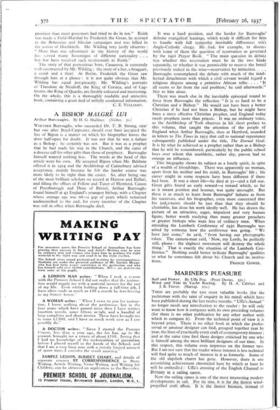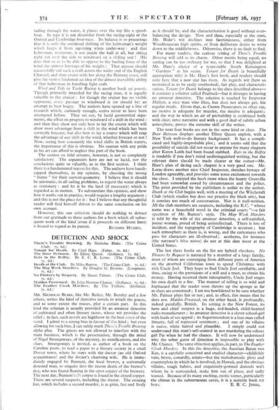MARINER'S PLEASURE
Sail and Power. By Uffa Fox. (Peter Davies. 35s.) Wind and Tide in Yacht Racing. By H. A. Calahan and J. B. Trevor. (Harrap. 21s.)
THESE are probably the two most valuable books (for the yachtsman with the taint of enquiry in his mind) which have been published during the last twelve months. "Uffa's Annual " no longer needs any introduction to the reader : he will only want to know how it compares with its own preceding volumes (for there is no other publication by any other author with which to compare it). From the technical point of view it is beyond price. There is no other book in which the profes- sional or amateur designer can find, grouped together year by year, the lines of practically every craft of contemporary interest ; and at the same time, find those designs criticised by one who is himself among the- most brilliant designers of our time. In this respect, this volume even improves on the former two. But I am not sure that the reader whose interest is less technical will find quite so much of interest in it as formerly. Some of the old slapdash charm has gone. However, there is one astonishing achievement chronicled here by which at least he will be enthralled : Uffa's crossing of the English Channel to Brittany in a sailing canoe.
Now the sailing canoe is one of the most interesting modern developments in sail. For its size, it is far the fasten,); wind- propelled craft afloat. It is the fastest because, instead of sailing through the water, it planes over the top like a speed- boat. In type it is not dissimilar from the racing-eight of the Oxford and Cembridge.boat-race. Its balance is so precarious that it is only the continual shifting of the helmsman's weight which keeps it from capsizing when under-way : and that helmsman, moreover, is not inside the hull at all, but sitting right out over the side to windward on a sliding seat ! (He does that so as to be able to oppose to the heeling force of the wind the utmost leverage. of his weight.) That anyone should successfully sail such a craft across the wider end of the English Channel, and then cruise with her along the Brittany coast, will give the veriest landsman an idea of the almost incredible ability of that helmsman in handling light craft.
Wind and Tide in Yacht Racing is another book sui generis. Though primarily intended for the racing man, it is equally valuable to the cruiser : for though the cruiser has no visible opponent, every passage to windward is (or should be) an attempt to beat bogey. The authors have opened up a line of research which, curiously enough, seems never to have been attempted before. They set out; by lucid geometrical argu- ments, the effect on progress to windward of a shift in the wind : and then they show not only how to lay the course which will draw most advantage from a shift in the wind which has been correctly forecast, but also how to lay a course which will reap the advantage of any shift in the wind, whether forecast or not ! Now, seeing how constantly the wind shifts in British waters, the importance of this is obvious. No seaman with any pride in his art can afford to neglect this part of the book.
The section on tidal streams, however, is not so completely satisfactory. The arguments here are not so lucid, nor the conclusions quite so valuable, as in the first section. I think there is a fundamental reason for this. The authors have handi- capped themselves, in my opinion, by choosing the wrong " frame " for their current-geometry. I believe that it should be axiomatic, in all sailing problems, to regard the water always as stationary : and let it be the land (if necessary) which is regarded as in motion. To substantiate this opinion, and show how it works out in practice, would require a lengthy argument ; and this is not the place for it : but I believe that any thoughtful reader will find himself driven to the same conclusion on his own account.
However, this one criticism should do nothing to detract from our gratitude to these authors for a book which all subse- quent work of the kind (even if it proceeds on different lines)



















































 Previous page
Previous page